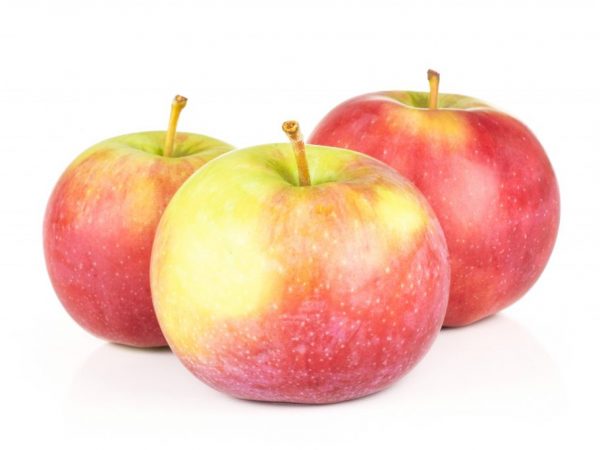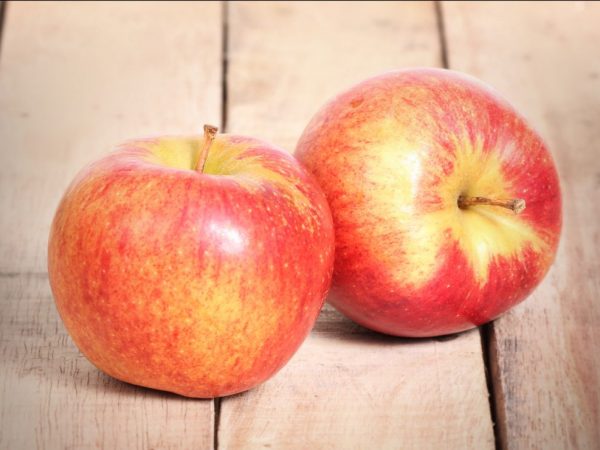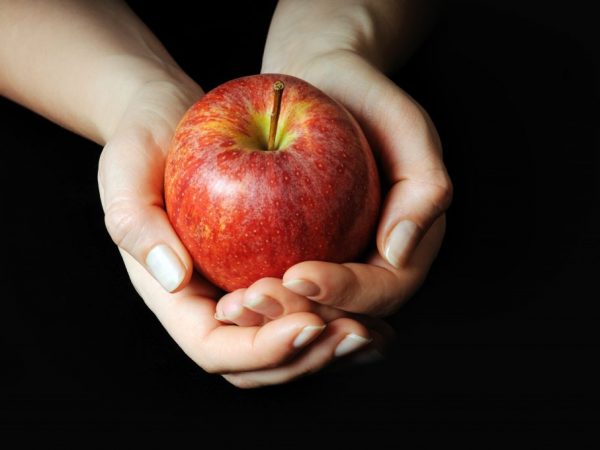Growing an apple tree Jonagold
Jonagold apples are popular all over the world and are characterized by high yields. The hybrid was bred in New York from the varieties Jonathan and Golden Delicious. The fruits are large and retain their freshness and taste for a long time.

Growing an apple tree Jonagold
Variety characteristic
There are over 100 species in common with this apple tree. Such varieties may differ in appearance and taste.
Description of the tree and fruit
The crown of the apple tree has an oval shape at the initial stages of the development of the tree, but over the years it begins to press on the edges, forming a round shape. The branches grow in width, taking up a large amount of space.
Although the buds bloom rather quickly, young shoots appear slowly. Fruits that appear no earlier than 1 year after planting usually form ovaries on twigs and growths.
If trees are planted on frost-resistant seedlings, they can live up to 35 years, and if on piles of medium height - up to 25 years.
The apples of this variety are large enough and weigh from 150 to 250 g. The description suggests that their shape is round, but sometimes there are fruits that are slightly flattened on both sides, with roughness in the area of the calyx. The rind of the fruit is of medium thickness and sweetish in taste.
The calorie content of an apple is 45 kcal per 100 g. Its nutritional value has the following characteristics:
- carbohydrates - 12 g;
- fats - 0.5 g;
- proteins - 0.5 g
Sometimes the fruit is covered with a kind of rusty mesh. The pulp of the fruit has a light yellow hue and dense structure, and its aroma beckons with its sweetness. Often the color of the apple is yellow-green with a red blush on the sides and closer to the stalk. The pulp has a sweet and sour aftertaste with varying degrees of astringency.
Yield
The first harvest can be carried out as early as 2-3 years after planting the tree. On average, during the first 10 years, it can produce 15 kg of apples in one year of fruiting. In the future, for each season, about 60 kg of crops are harvested from one tree. Apples ripen in mid-September, when a purple hue appears on their lateral side.
Pollinators and clones

Apples may vary in appearance
Breeders have bred a huge number of clones of this variety. Among them, these varieties stand out:
- fruits with a smoothly stretched red crimson over the entire surface - Rubin-Star, Jomured;
- apples with a bright red, slightly washed out color - King Jonagold, Jonika;
- varieties with dark crimson colors, on which stripes are sometimes visible - Jonagold Decosta, Jonagored;
- fruits that range in color from the lightest to the darkest - Novayo;
- fruits of bright shades with clear lines - Wilmuth.
It is recommended to plant several pollinating trees near the Jonagold apple tree. The most suitable varieties are Champion, Jonathan, Idared, Melrose, etc.
Frost resistance
The apple variety is often referred to as early winter, becauseharvest at the end of September. If stored properly, the fruits may not lose their taste until mid-spring. It is recommended to grow the tree in regions with moderately cold winters, because drops of low temperatures are dangerous for him.
Disease and pest resistance
The Jonagold apple tree may well tolerate diseases and the effects of pests when applying special means and solutions. The description suggests that most often the culture is affected by scab, but this variety is resistant to it.
Frequent pests of such trees as apple trees are the moth, apple moth, silkworms, etc. Powdery mildew is one of the main enemies of culture, because signs of this disease can appear at any time of the year. This disease is known for the appearance of white spots on foliage (fungal spores).
If you do not take action, the spots darken and spread throughout the tree: on the shoots and fruits. In the spring, the shoots must be treated with Bordeaux solution. During the period when the buds begin to bloom, it is recommended to spray the tree with products with a high copper content.
Growing regions
The regions for the cultivation of this apple variety are quite diverse and occupy large areas with moderately cold winters. In such places, a predominantly temperate and warm climate. You can grow an apple tree in Ukraine, Belarus, America, in the central and southern parts of Russia.
Landing
It is recommended to plant trees in the spring or autumn before the first frost appears. In spring, this period lasts from late April to early May. Planting should be carried out in loose, well-fertilized soil.
The Jonagold apple variety loves well-lit places, so it is better for him to allocate an area that will not be darkened.
The landing site should have the following parameters: diameter - 1 m and depth - 70 cm. The bottom of this pit should be of a loose consistency. It is recommended to cover half of the deepening with fertile soil with admixtures of fertilizers.
Place a seedling in the hole. In this case, keep in mind that the vaccination site should be 10 centimeters above ground level. Fluff the roots over the entire area and sprinkle with soil.
Water the tree with up to 40 liters of water. During the development of the apple tree, it is necessary to provide it with abundant watering and feeding.
Also, the distance at which trees are supposed to be planted depends on the type of rootstock: dwarf (2 m), semi-dwarf (3 m) and vigorous (3.5 m).
Care

Top dressing is essential to get fruit.
To get a good harvest in the fall, a set of agricultural measures should be carried out, which includes these basic procedures:
- watering. The Jonagold apple tree belongs to dry-resistant varieties, but still requires abundant watering. This is necessary to get large juicy fruits regardless of weather conditions. Seedlings, for which water helps to better absorb minerals from the soil, especially require watering;
- top dressing is useful at all periods of tree formation, it is brought under the very root and the space around it. In the near-stem area, it is recommended to periodically plow the soil so that the air soaks well all layers of the soil and saturates the root system. For the winter, it is necessary to mulch the apple tree with humus, hay or humus;
- crown pruning plays an important role in the formation of a healthy tree. It is not recommended to prune seedlings until the main part of the tree has formed. The crown is formed 2-3 years after planting. In the spring, it is necessary to carry out sanitary, shaping and rejuvenating pruning, with which you can transfer most of the nutrients to the fruits, removing unnecessary branches. There are several suitable crown forms: cupped, bushy and fusiform. If the branches growing up are pruned in the early stages, it is recommended to prune the lateral crown at a later stage in the development of the tree.
Ripening, collection and storage of fruits
You can get the first harvest with proper planting and care within 2-3 years after planting the apple tree. In the future, the number of fruits will only increase. Apples begin to ripen from mid-September, and you can start picking as early as early October.
During this period, the fruit will have a yellowish color with pinkish blotches. Sometimes even green fruits can come across, but do not worry about this. Within a couple of months, the apple will ripen and acquire a reddish tint.
Full ripeness is observed already in January, when the fruit acquires its best taste and aroma.
The yield depends on the age of the tree:
- 7-8 years old - up to 15 kg of apples;
- 9-13 years old - you can get up to 50 kg of fruits;
- apple trees over 13 years old bring up to 80 kg per tree.
You can store apples in the refrigerator at a temperature of 2-3 ° C. With this approach, this variety can last until April. The higher the temperature at which the crop is stored, the less time the apples will be able to remain edible.
Species diversity
With various crossing of trees, quite popular varieties of the Jonagold apple tree were bred:
- King. Fruits are yellow with red blotches. Has a high resistance to disease and frost. By their structure, these are low-growing trees with apples weighing 150 g;
- Morens is the most popular variety with high tasting scores - up to 5 points. Fruits weigh up to 230 g and are stored for up to 7 months from October. The fruits are resistant to low temperatures and have good immunity.
Gardeners reviews
Jonagold apples and all of its clones can be eaten both fresh and canned. They make delicious juices and jams. The fruits are also suitable for making baby food.
Having studied the reviews of gardeners on whose site there are apple trees of this variety, we can conclude that its fruits are suitable for winter storage. Before that, it is necessary to carry out measures for the correct packaging of fruits so that they remain fresh as long as possible.
With the correct planting and proper care of the tree, you can get a significant harvest with high taste characteristics.

